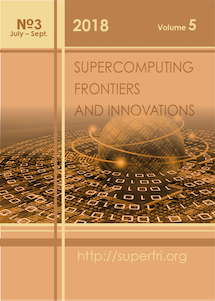GPU-based Implementation of Discrete Element Method for Simulation of the Geological Fault Geometry and Position
DOI:
https://doi.org/10.14529/jsfi180307Abstract
We present an algorithm for numerical simulation of the geological fault formation. The approach is based on the discrete elements method, which allows modeling of the deformations and structural discontinuity of the Upper part of the Earth crust. In the discrete elements method, the medium is represented as an combination of discrete particles which interact as elastic or viscoelastic bodies. Additionally, external potential forces, for example gravitational forces, may be introduced. At each time step the full set of forces acting at each particle is computed, after that the position of the particle is evaluated on the base of Newtonian mechanics. We implement the algorithm using CUDA technology to simulate single statistical realization of the model, whereas MPI is used to parallelize with respect to different statistical realizations. Obtained numerical results show that for low dip angles of the tectonic displacements relatively narrow faults form, whereas high dip angles of the tectonic displacements lead to a wide V-shaped deformation zones.
References
Alpak, F.O., Gray, F., Saxena, N., Dietderich, J., Hofmann, R., Berg, S.: A distributed parallel multiple-relaxation-time lattice boltzmann method on general-purpose graphics processing units for the rapid and scalable computation of absolute permeability from high-resolution 3D micro-ct images. Computational Geosciences 22(3), 815–832 (2018), DOI: 10.1007/s10596- 018-9727-7,
Hardy, S., Finch, E.: Discrete-element modelling of detachment folding. Basin Research 17(4), 507–520 (2005), DOI: 10.1111/j.1365-2117.2005.00280.x
Lisjak, A., Grasselli, G.: A review of discrete modeling techniques for fracturing processes in discontinuous rock masses. Journal of Rock Mechanics and Geotechnical Engineering 6(4), 301–314 (2014), DOI: 10.1016/j.jrmge.2013.12.007
Mora, P., Place, D.: Simulation of the frictional stick-slip instability. Pure and Applied Geophysics 143(1), 61–87 (1994), DOI: 10.1007/BF00874324
Peacock, D.C.P., Dimmen, V., Rotevatn, A., Sanderson, D.J.: A broader classification of damage zones. Journal of Structural Geology 102, 179–192 (2017), DOI: 10.1016/j.jsg.2017.08.004
Downloads
Published
How to Cite
Issue
License
Authors retain copyright and grant the journal right of first publication with the work simultaneously licensed under a Creative Commons Attribution-Non Commercial 3.0 License that allows others to share the work with an acknowledgement of the work's authorship and initial publication in this journal.

